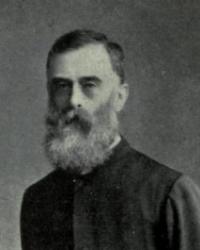Planning worship?
Check out our sister site, ZeteoSearch.org,
for 20+ additional resources related to your search.
- |
User Links
Person Results
Anonymous
Author of "The Father's Sole Begotten Son" in The Cyber Hymnal In some hymnals, the editors noted that a hymn's author is unknown to them, and so this artificial "person" entry is used to reflect that fact. Obviously, the hymns attributed to "Author Unknown" "Unknown" or "Anonymous" could have been written by many people over a span of many centuries.
Anonymous
John Bacchus Dykes

1823 - 1876 Person Name: John Bacchus Dykes, 1823-1876 Composer of "TRINITY COLLEGE" in The Cyber Hymnal As a young child John Bacchus Dykes (b. Kingston-upon-Hull' England, 1823; d. Ticehurst, Sussex, England, 1876) took violin and piano lessons. At the age of ten he became the organist of St. John's in Hull, where his grandfather was vicar. After receiving a classics degree from St. Catherine College, Cambridge, England, he was ordained in the Church of England in 1847. In 1849 he became the precentor and choir director at Durham Cathedral, where he introduced reforms in the choir by insisting on consistent attendance, increasing rehearsals, and initiating music festivals. He served the parish of St. Oswald in Durham from 1862 until the year of his death. To the chagrin of his bishop, Dykes favored the high church practices associated with the Oxford Movement (choir robes, incense, and the like). A number of his three hundred hymn tunes are still respected as durable examples of Victorian hymnody. Most of his tunes were first published in Chope's Congregational Hymn and Tune Book (1857) and in early editions of the famous British hymnal, Hymns Ancient and Modern.
Bert Polman
John Bacchus Dykes
Thomas Benson Pollock

1836 - 1896 Person Name: Thomas B. Pollock Translator (from Latin) of "The Father's Sole Begotten Son" in The Cyber Hymnal Pollock, Thomas Benson, M.A., was born in 1836, and graduated at Trinity College, Dublin, B.A. 1859, M.A. 1863, where he also gained the Vice-Chancellor's Prize for English Verse in 1855. Taking Holy Orders in 1861, he was Curate of St. Luke's, Leek, Staffordshire; St. Thomas's, Stamford Hill, London; and St. Alban's, Birmingham. Mr. Pollock is a most successful writer of metrical Litanies. His Metrical Litanies for Special Services and General Use, Mowbray, Oxford, 1870, and other compositions of the same kind contributed subsequently to various collections, have greatly enriched modern hymnbooks. To the 1889 Supplemental Hymns to Hymns Ancient & Modern, Mr. Pollock contributed two hymns, “We are soldiers of Christ, Who is mighty to save" (Soldiers of Christ), and "We have not known Thee as we ought" (Seeking God), but they are by no means equal to his Litanies in beauty and finish.
-- John Julian, Dictionary of Hymnology (1907)
===================
Pollock, T. B. , 900, i. We note:—
1. God of mercy, loving all. Litany for Quinquagesima. In the Gospeller, 1872.
2. Great Creator, Lord of all. Holy Trinity. In the Gospeller, 1876.
3. Holy Saviour, hear me; on Thy Name I call. Litany of the Contrite. In the Gospeller, 1870. From it "Faithful Shepherd, feed me in the pastures green," is taken.
4. Jesu, in Thy dying woes, p. 678, ii. 36. Given in Thring's Collection, 1882, in 7 parts, was written for the Gos¬peller.
5. My Lord, my Master, at Thy feet adoring. Passiontide. Translation of "Est-ce vous quo je vois, 6 mon Maître adorable!" (text in Moorsom's Historical Comp. to Hymns Ancient & Modern, 1889, p. 266), by Jacques Bridaine, b. 1701, d. 1767. Moorsom says he was born. at Chuselay, near Uzes, in Languedoc, and was a Priest in the French Church. The translation made in 1887 was included in the 1889 Supplemental Hymns to Hymns Ancient & Modern.
6. We are soldiers of Christ, p. 900, i. In the Gospeller, 1875.
7. Weep not for Him Who onward bears. Passiontide. No. 495 in the 1889 Suppl. Hymns to Hymns Ancient & Modern is part of a hymn in the Gospeller, 1870.
--John Julian, Dictionary of Hymnology, Appendix, Part II (1907)
Thomas Benson Pollock


 My Starred Hymns
My Starred Hymns


